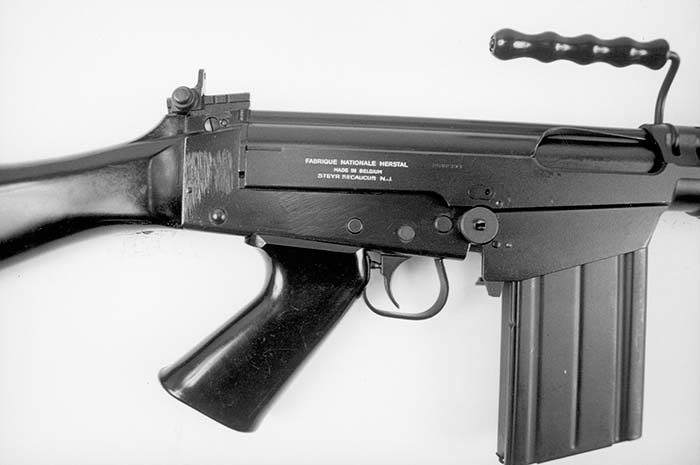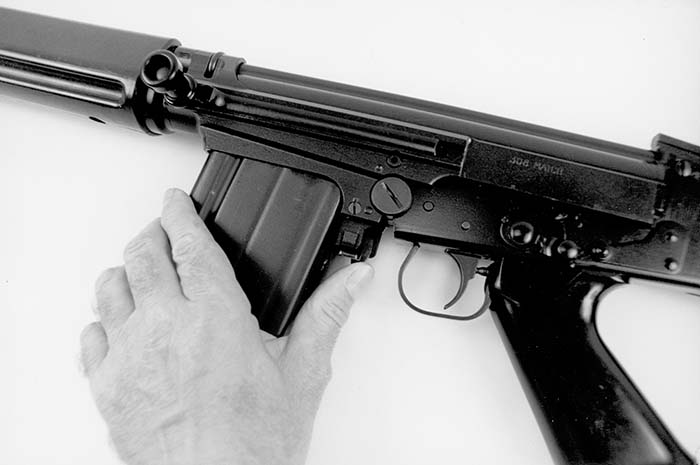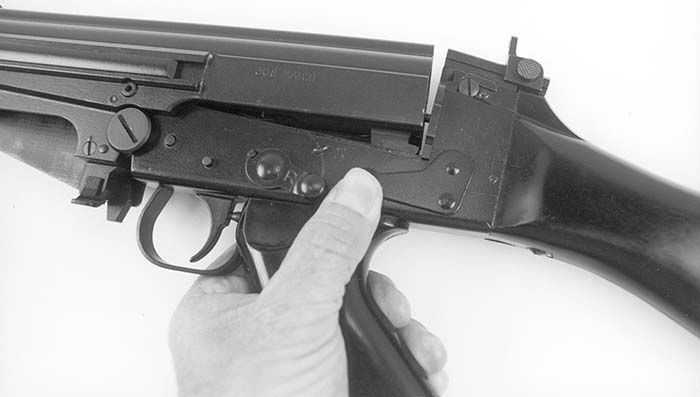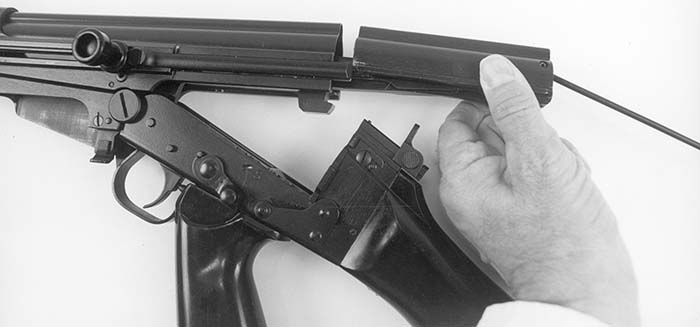Frank Iannamico
The famous Belgium Fabrique Nationale – Fusil Automatique Leger (Light automatic rifle) or FN-FAL rifle is the most prolific 7.62 NATO caliber battle rifle in the world, being adopted by 93 nations. The FN-FAL was also manufactured under license in several countries. There were quite a few variants although most of the differences were minor, being limited to the sights, furniture, flash suppressors and other minute details. The weapon evolved from a post war desire by the allies of WWII, Canada, Great Britain, France and the United States, to issue a common service rifle and cartridge. In 1949 these and several other countries formed the North Atlantic Treaty Organization, more commonly know as NATO. Choosing a standard NATO rifle proved to be extremely difficult due to national pride, bureaucrats, and difference of opinion. Although the U.S. 7.62 cartridge was eventually adopted as NATO standard in December 1953, many of the countries of the alliance would have preferred to adopt a cartridge that was more similar to the intermediate power 7.92 Kurz round introduced by the Germans near the end of WWII. In fact the very first FAL prototype had been chambered for the German short round, making it a true mid-range assault rifle.
Several countries had already done extensive post-war development work on their own mid-range rounds. Great Britain had developed her own intermediate cartridge, the 7 x 43mm,or .280 caliber round. The United States Ordnance Department however, was not quite as enamored as everyone else by the then new assault rifle concept and its mid range capability. The U.S. Ordnance Department tested several British rifles in 1950, including a prototype .280 caliber FAL. They were promptly rejected. The U.S. insisted on, and eventually got, its powerful 7.62×51 round adopted by NATO. The 7.62 cartridge’s ballistics were similar to that of the WWII 30’06 round but in a case that was 12 mm shorter.

The United States extensively tested the FN FAL as the T48 rifle, chambered for the U.S. 7.62 round (T-65), from 1952 until the official adoption of the M14 rifle in May of 1957. An educational contract was awarded to Harrington & Richardson Inc. to manufacture 500 7.62 mm FN-FALs (T48s), as a study to see what problems might be encountered in domestic manufacture of the weapon. The Ordnance Department finally concluded after years of testing and development that both the 7.62 caliber T-48 (FN-FAL) and the T-44E4 (M14) were “suitable for army use”. In a decision that had been expected from the outset of the testing program, the U.S. Ordnance Department declared their own design, the T44E4, as the winner and the weapon was adopted as the new service rifle of the U.S. Army. The new rifle was designated as the “U.S. Rifle 7.62 M14.” The reasons given for choosing the T-44 over the T-48 were: the T-44 was 1 pound lighter, had fewer parts, had no need for a manual gas regulator, and it would be easier to manufacture because of the similarities to the M1 rifle. While the U.S. Army adopted the M14 the rest of the free world choose the FN FAL.

The FN-FAL is known by many different nomenclatures designated by the adopting countries: the British L1A1, Austrian STG58, the German G-1, the Canadian C1A1 and others. The FN-FAL was available in several models including, the standard rifle, and the para-folding stock version and the FALO, heavy barrel model. The heavy barrel models were usually equipped with an integral folding bipod. The FAL rifle was manufactured in both metric and inch configurations. The FALs adopted by the British and most Commonwealth nations, including India, Canada and Australia were manufactured in the inch pattern while the remaining countries adopted the metric design. The inch pattern guns have virtually the same outward appearance as the metric rifles and a few parts will interchange between models. The magazines are also dimensionally different. The metric magazines will usually work in an inch pattern rifle, but the inch pattern magazines will not fit into the magazine well of a metric gun. While the FAL was capable of full automatic fire (650-700 RPM) many countries chose to issue the rifle in semi-auto only. Because of the powerful cartridge and the relatively light weight of the weapon it was difficult to manage during full auto fire.
The FAL is a gas-operated, select fire weapon that uses a tilt-to-lock bolt system. The standard model is 43.6 inches in length, and weighs a hefty 10.3 pounds loaded. The magazine is a detachable box style with a 20 round capacity. Standard barrel length is 21 inches, four right-hand grooves, one turn in 12 inches (varies). Muzzle velocity with standard NATO military ball ammunition is 2800 feet per second. A non-reciprocating cocking handle is located on the left side of the receiver, with inch-pattern models featuring a folding cocking handle. An adjustable gas regulator is provided to insure reliable operation under extended use in the field. Most FAL models are equipped with a receiver mounted, folding carry handle that is located at weapons center of gravity. The weapon is very well made, extremely rugged and reliable.
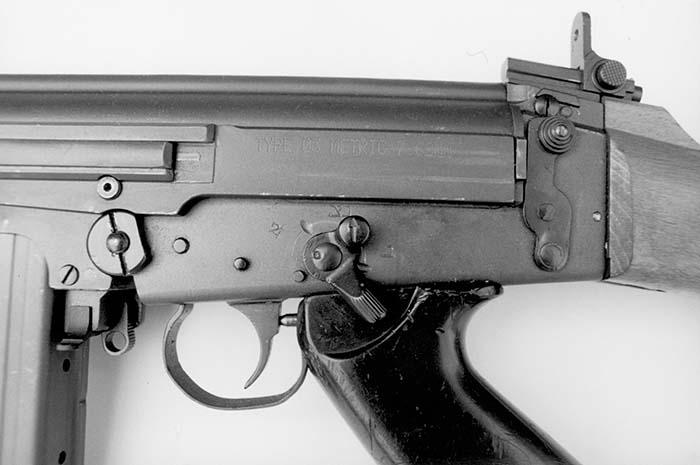
The basic FAL rifle was manufactured in different models. U.S. collectors commonly use the Belgian designations to describe the configuration of a particular FAL regardless of the country of origin.
•Model 50.00 The standard full stocked version.
•Model 50.41 Heavy barrel.
•Model 50.63 Folding stock, 18-inch barrel.
•Model 50.64 Folding stock 21-inch barrel.
Civilian FN-FALs
From 1959 to 1963 a limited number (1,848 according to the BATF) of German G1 pattern rifles (FN-FALs) were approved for importation into the United States. These were imported by the Browning Arms Company and are commonly know as the G series FALs, because of the letter G or GL prefix on their serial numbers. What make these rifles unique is they have the original military sear cut receivers, although most were imported in a semi-automatic-only configuration. These rifles are eagerly sought after today and are on the BATF’s Curio and Relics list. 1950s H&R manufactured T-48s, and the Canadian experimental models made by FN, although quite rare in private hands, are also considered C&R firearms.
In the early 1980s BATF approved, semi-automatic-only, versions of modern military rifles were being offered on the U.S. civilian market. Military contractors like FN, Colt, H&K, IMI, Steyr and even former Warsaw Pact countries began producing guns for U.S. collectors and shooters. Although by the 1980s the FN-FAL was obsolete as a military weapon, FN of Belgium offered the rifle to an enthusiastic U.S. market. The only drawback was that the FN-FAL, now designated as the FN-LAR (Light Automatic Rifle), had a very high asking price and thus was passed over by many buyers for less expensive weapons.
Selected manufacturers suggested list prices circa 1983:
•Colt AR-15 $533.00, (5.56mm)
•Fabrique Nationale FNC $695.00, (5.56mm)
•H&K Model 91 $699.00 (7.62 NATO)
•Springfield Armory M1A1 $775.00 (7.62 NATO)
•Steyr Aug $1275.00 (5.56mm)
•Fabrique Nationale FN-LAR $1695.00 (7.62 NATO)
Importers began searching the globe for more affordable versions of the FN-FAL. Soon reasonably priced semi-automatic FAL rifles built under license in Argentina by FMAP DM Rosario were being imported into the United States. Armscorp of Maryland imported a number of FAL parts kits from Israel and assembled them on new manufacture semi-automatic receivers. Brazilian FALs were being imported by Springfield Armory and offered as the SAR-48. Even a small number of rare inch-pattern Lithgow L1A1 rifles were imported from Australia. Looking back one can honestly say, “Those were the days”.
The FAL today
Because of laws passed in recent years, many new categories of semi-automatic firearms have emerged. Today phrases such as sporter, pre-ban, post-ban, pre 1989, etc. are common parlance. Essentially all that these new laws have done is raise prices of the pre-ban guns to the point to where they have become expensive collector’s items. After the 1989 ban new “sporter” models of assault rifles began to appear. These guns were mechanically similar to the original guns, but equipped with thumbhole stocks, and without flash-hiders, bayonet lugs or separate pistol grips. While certainly adequate shooters, the rifles had lost a lot of their appeal to the more serious enthusiast.
More recently FN-FAL parts kits from a variety of countries have become available at very reasonable prices. These kits are generally in very good condition and complete, except of course, for the receiver. New manufacture receivers are also currently being offered. One of the earliest semi-auto-only receivers was manufactured by Imbel of Brazil, who had been manufacturing the FN FAL rifle for a number of years under license. Unfortunately these receivers where banned form further importation in 1997-98. Currently there are several U.S. based companies manufacturing FAL receivers: Hesse Ltd., Entréprise Arms and DSA Inc. In addition to receivers, there are several U.S. companies manufacturing FAL parts. Installation of at least 7 U.S. made parts in a FN-FAL places them in a category that allows a separate pistol grip and stock to be utilized. Although flash hiders are still disallowed, permanently attached muzzle brakes are permitted. FALs in this configuration are more appealing and can be obtained at a very reasonable cost. The availability of these “kit guns” has caused quite a resurgence of shooter interest in the classic FAL.
NOTE: Assembly of a FAL parts kit to a new receiver requires the services of a qualified gunsmith who is familiar with the weapon. In addition, be absolutely certain that you will be in compliance with all federal and local laws before undertaking such a project. There are several suppliers offering the FALs already assembled in various configurations.
As you read this article you can begin to get an idea of just how much our second amendment rights have deteriorated over the past decade. What will the next decade bring? Protect your rights, register and vote.
Sources for FAL receivers and part sets:
DSA Inc. 847-277-7258
Entreprise Arms 626-962-8712
Hesse Arms 651-455-5760
Inter-Ordnance 704-225-8843
SARCO Inc. 908-647-3800
| This article first appeared in Small Arms Review V5N3 (December 2001) |





